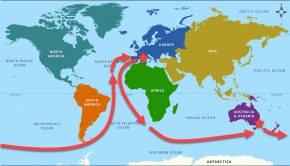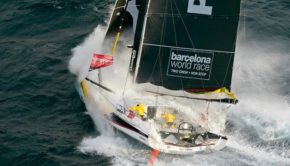Weekend rendezvous at Cape Horn
Published on February 27th, 2015
(February 27, 2015; Day 59) – Cape Horn beckons for second and third placed Neutrogena and GAES Centros Auditivos. While the two IMOCA 60s are expected to pass at speed with around six hours of separation, in what might be considered favourable conditions for one of the most inhospitable and complicated corners of the Barcelona World Race, amidst the long hours of stress and fatigue, there will surely still be moments for the crews to reflect, individually and together.
Aboard second placed Neutrogena, due to pass between 0200hrs and 0600hrs UTC this Saturday it will be the high point of the race for José Muñoz. Just under five years ago he and his co-skipper, friend and mentor Felipe Cubillos, became the first Chileans to race around Cape Horn in a round the world race when leading the Class 40 Global Ocean Race.
Subsequently Cubillos, a prime mover in Chilean sailing, an entrepreneur and charity activist died in 2011 in a plane crash. He was an inspirational character who, shortly before he and Muñoz rounded the rock for the first time, wrote:
“Everyone can fulfill their dreams if they apply passion and determination. If you can overcome pessimism, self-doubt and triumph over the fear of failure, it is worth it as the prize at the end is immense. For me – and possibly many of you – it is our reason for living. Each of us has a personal Cape Horn: it’s a matter of locating this goal and then heading straight for it.”
As much as he can under the circumstances – weather and in the race situation permitting – Muñoz hopes to share the moment with his countrymen and remember his friend and co-skipper.
Muñoz said today: “We know that for every single sailor yearns to cross Cape Horn. Obviously, that’s not always possible, due to the extreme weather conditions there at the most southern cape in the world. It will be very emotional and I hope we can pay tribute to my friend [Felipe Cubillos] when we’ll be close to the cape. He was the one who helped me and pushed me to fulfill my dream of putting a Chilean boat in the international races. I hope I can share it with my people.”
Neutrogena’s Catalan skipper Guillermo Altadill will cherish the moment just as much as he has done on each of the previous nine passages of the Great Cape, first rounding in 1989:
“It marks different times in the history of sailing. The first time I sailed around the world was in 1989 and it was completely different, we really were just a bunch of friends almost non professional sailing around the world, for us it was big thing to pass the Horn. Then during the last years each time it feels like sailing gets more and more professional, but the Cape is still the same thing for all the sailors. It does not matter if it is the beginning of your career or when you are more professional, it is always a special moment. It means you are leaving the Southern Ocean, you are leaving days and nights of huge waves, windy, more stress, more worries, round Cape Horn means the beginning of the way to go back home, to approach the finish line, to go towards better temperatures, to better conditions and that’s always a good moment. Not many people do it. Not many people do it many times in your life, so it is always a special moment at Cape Horn.”
Chasing just 119 miles behind on GAES Centros Auditivos, the passage of Cape Horn will really highlight just how far Anna Corbella and Gerad Marin have progressed since they both completed the race – on different boats – in 2011. Racing with Dee Caffari, when Corbella became the first Spanish woman to race around the Horn, their GAES Centros Auditivos then rounded 12 days later than they should this time.
Race leaders Cheminées Poujoulat had a reminder last night that the ascent of the South Atlantic can offer conditions as bad, if not worse than anything they saw in the Southern Oceans. Bernard Stamm said that huge, post frontal crossed seas and winds gusting to just under 50kts had forced them to slow right down.
Meantime Nandor Fa and Conrad Colman ended their technical pit stop in Bluff, South Island NZ, docking out at midday today (UTC) resuming racing at 1330hrs UTC.
“We had three really tough days of work, but it was quite easy and tiring. We got everything we needed to do finished and made some other jobs too. It was really tiring but we are ready to go, it was successful and tiring,” Nandor Fa said.
Colman added: “Nandor and I work well together. We are getting better and better as a team all the time.”
Double race winner Jean-Pierre Dick, speaking from the Atlantic where he is delivering his MOD70 back to Europe, confirmed that he wants the Barcelona World Race to be on his race calendar with his new IMOCA 60 in the future:
“I would return to race without hesitation. I have won twice and it is such a different exercise than solo. The human aspect is so much stronger. And when I see the ages of Jean and Bernard I can see I still have some time on my side. I don’t know if that great media article after François Gabart won the the Vendée Globe said it’s a race ” for young people.” It would be fun to be able to respond: “Long live the old …”
Skippers quotes:
Bernard Stamm (SUI) Cheminées Poujoulat:
It’s always a bit like a washing machine, we are in the depression. We will keep the strong wind for a while. Last night in fact we had the strongest winds since the start of the race. We believe that we passed Cape Horn and that’s the worst bit, but that’s not quite right.
* The South Atlantic is rarely easy?
South America does not stop depressions. When you are between 50 and the 40 deg S it is still a southern oceans regime. Here it was difficult. We had 45 knots and the boat surges to over 30kts and just plants itself into the big waves. After the static depressions off the Brazilian coast we get to the lighter winds. This is a long, complicated part of the journey.
* The climb up the Atlantic is long and the the guys are always tired?
The boats show the strains and wear of two third of the race. Materials and equipment begins to tire. There is the belief that its over, but far from it. For sure we have a flow which lets us advance well, but it is hard to go fast because the seas are really big. Just after the front like we are, it is not possible, we had crossed seas, it was impossible to go fast. But we get there anyway, this system is with us for a while so its pretty good.
Ranking at 14:00 UTC:
1. Cheminées Poujoulat (Bernard Stamm – Jean Le Cam) 6066 nm Distance to Finish
2. Neutrogena (Guillermo Altadill – Jose Muñoz) 1024 nm Distance to Lead
3. GAES Centros Auditivos (Anna Corbella – Gerard Marin) 1143 nm DTL
4. We Are Water (Bruno Garcia – Willy Garcia) 3451 nm DTL
5. One Planet One Ocean / Pharmaton (Aleix Gelabert – Didac Costa) 3606 nm DTL
6. Renault Captur (Jörg Riechers – Sebastien Audigane) 4184 nm DTL
7. Spirit of Hungary (Nandor Fa – Conrad Colman) 5377 nm DTL
Hugo Boss (Alex Thomson – Pepe Ribes) Abandon
Report by event media.
Background: The third edition of the Barcelona World Race is the only double-handed, non-stop, round the world race. Eight IMOCA 60 teams started December 31, 2014, with the intent to cover 23,450 nautical miles in a circumnavigation from Barcelona to Barcelona, putting the capes of Good Hope (South Africa), Leeuwin (Australia) and Horn (Chile) to port and the Antarctic to starboard. The finishes are forecasted for the end of March 2015.








 We’ll keep your information safe.
We’ll keep your information safe.